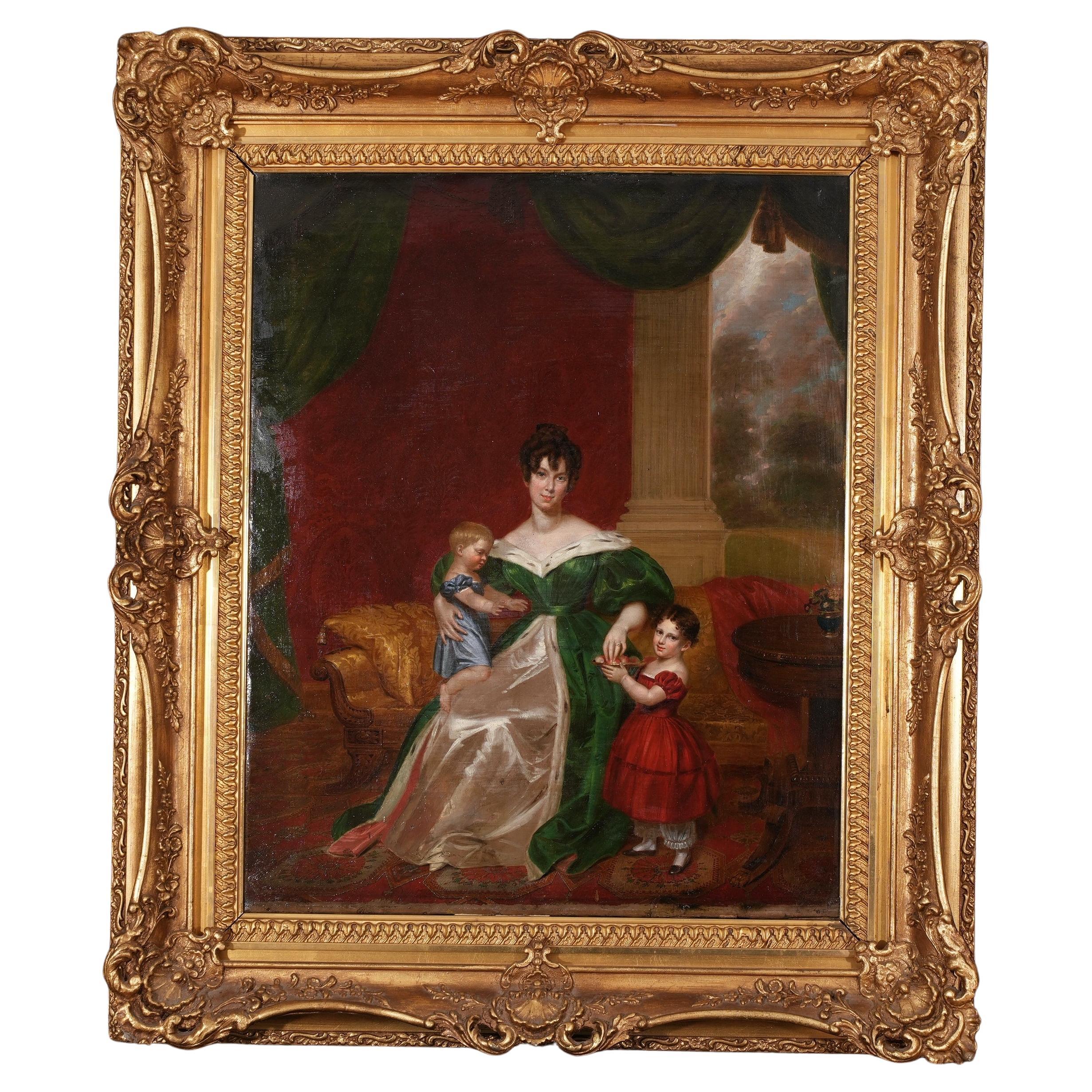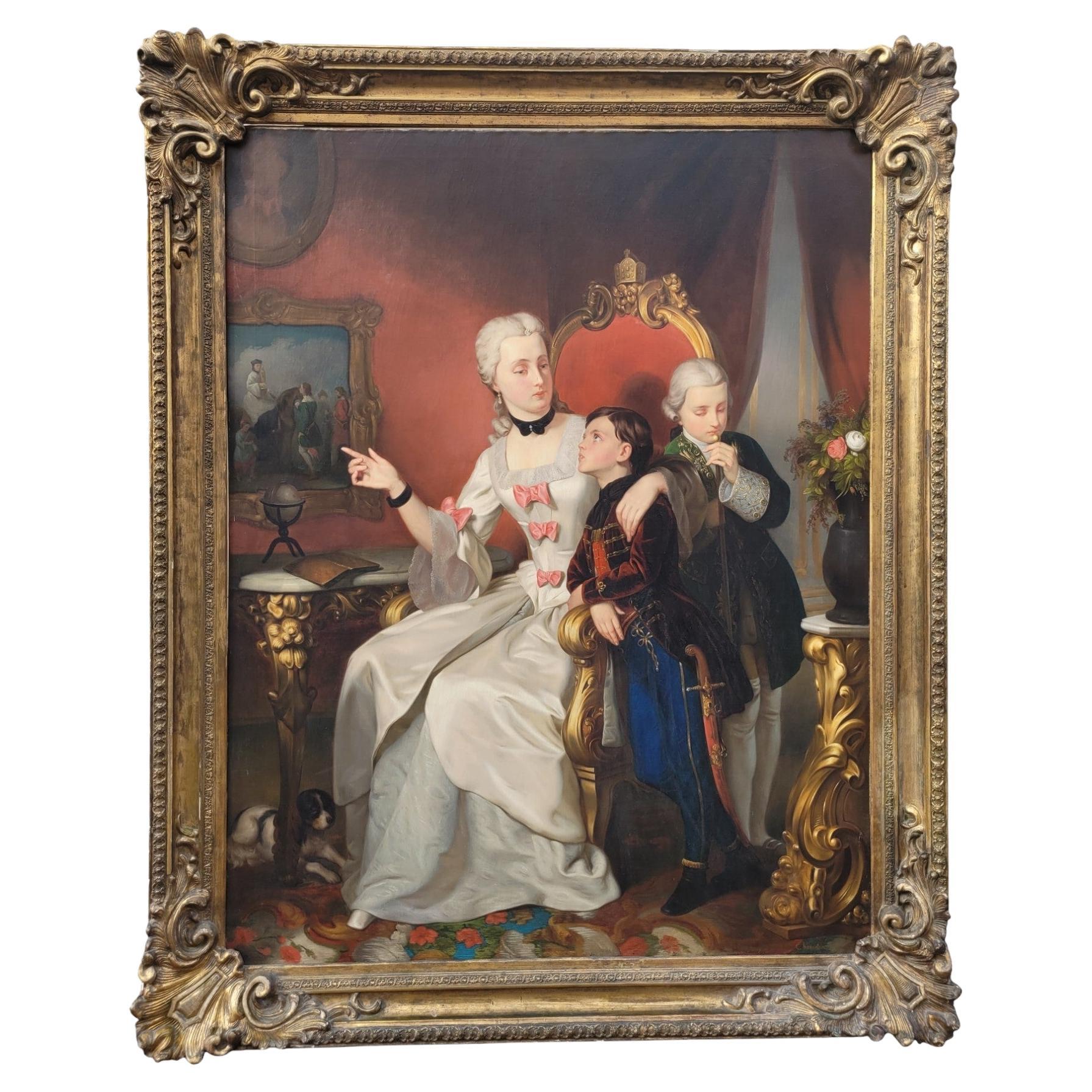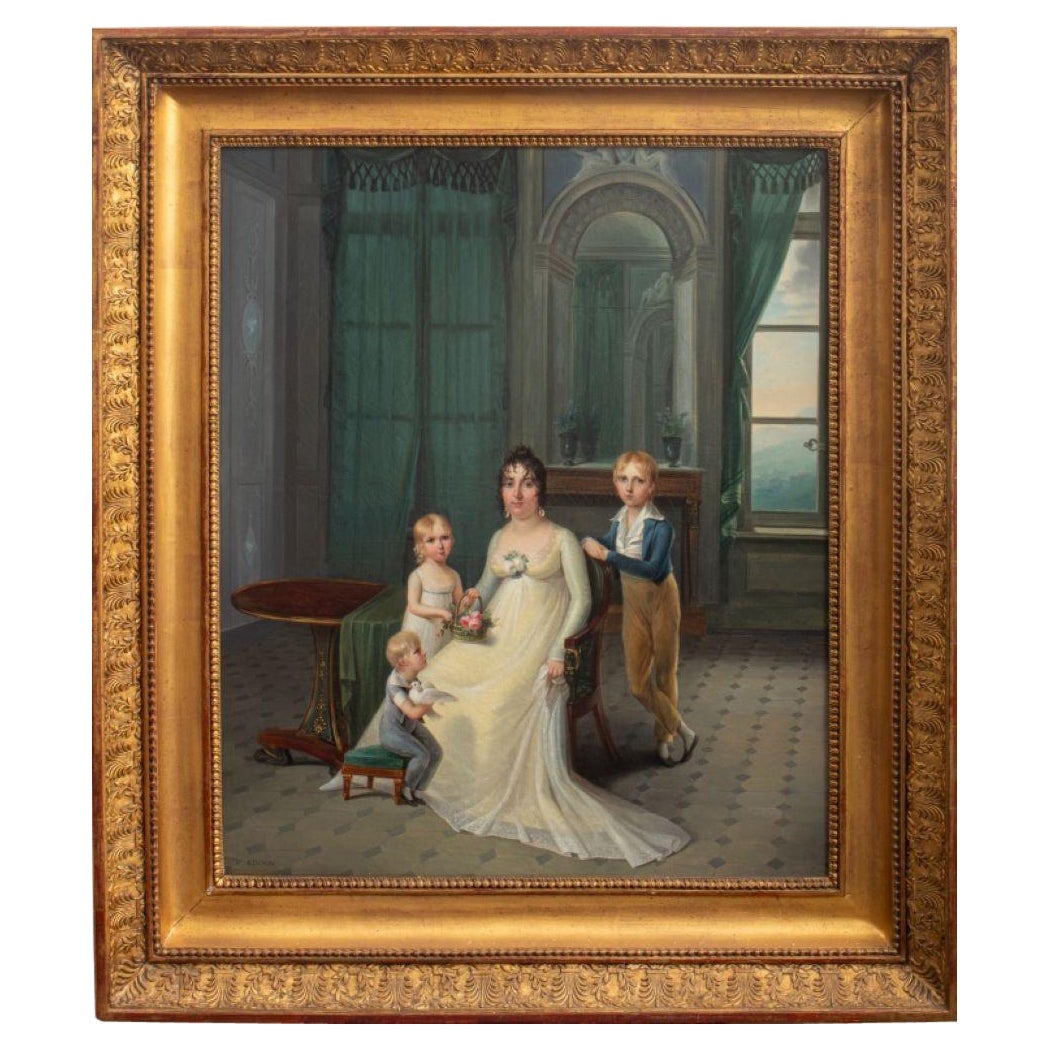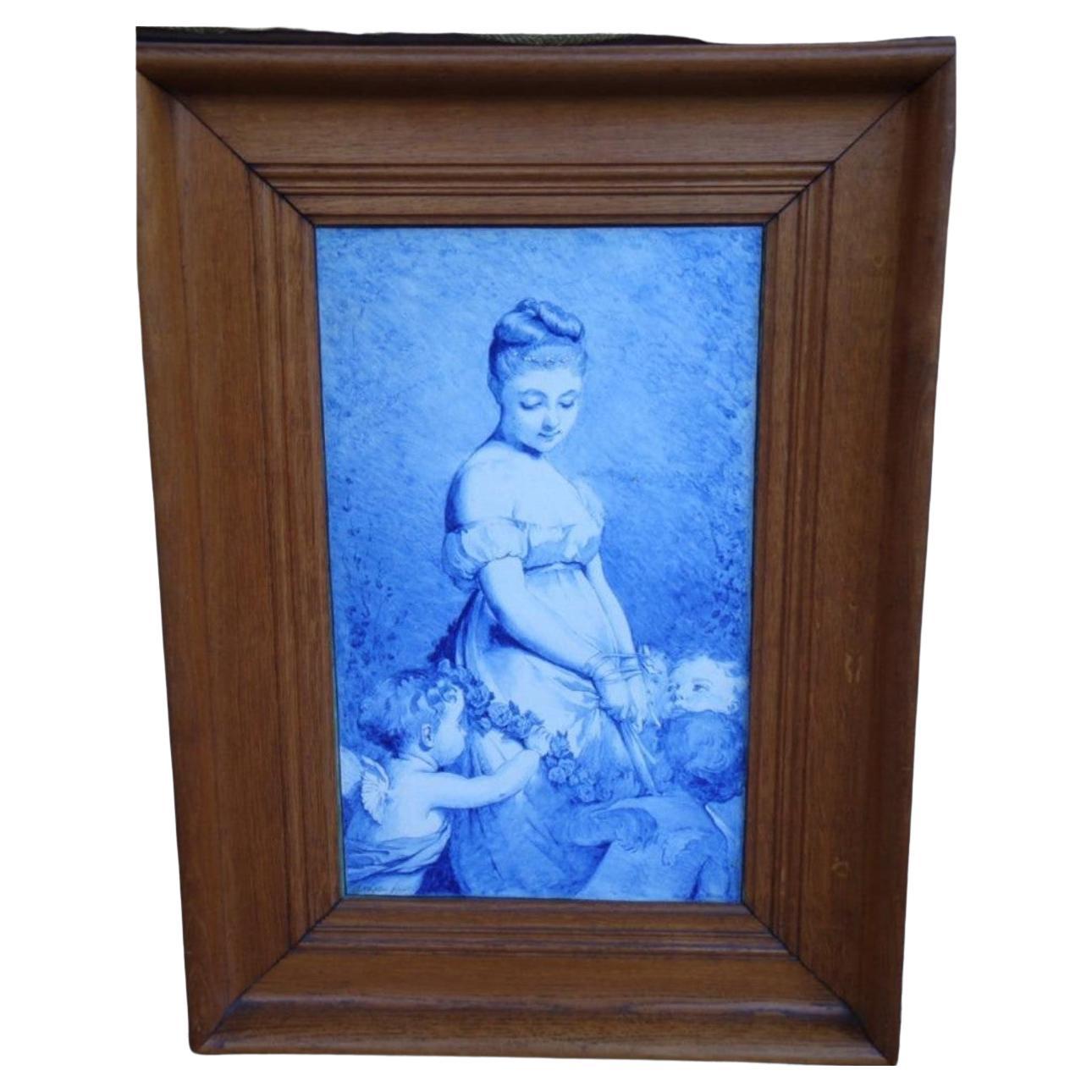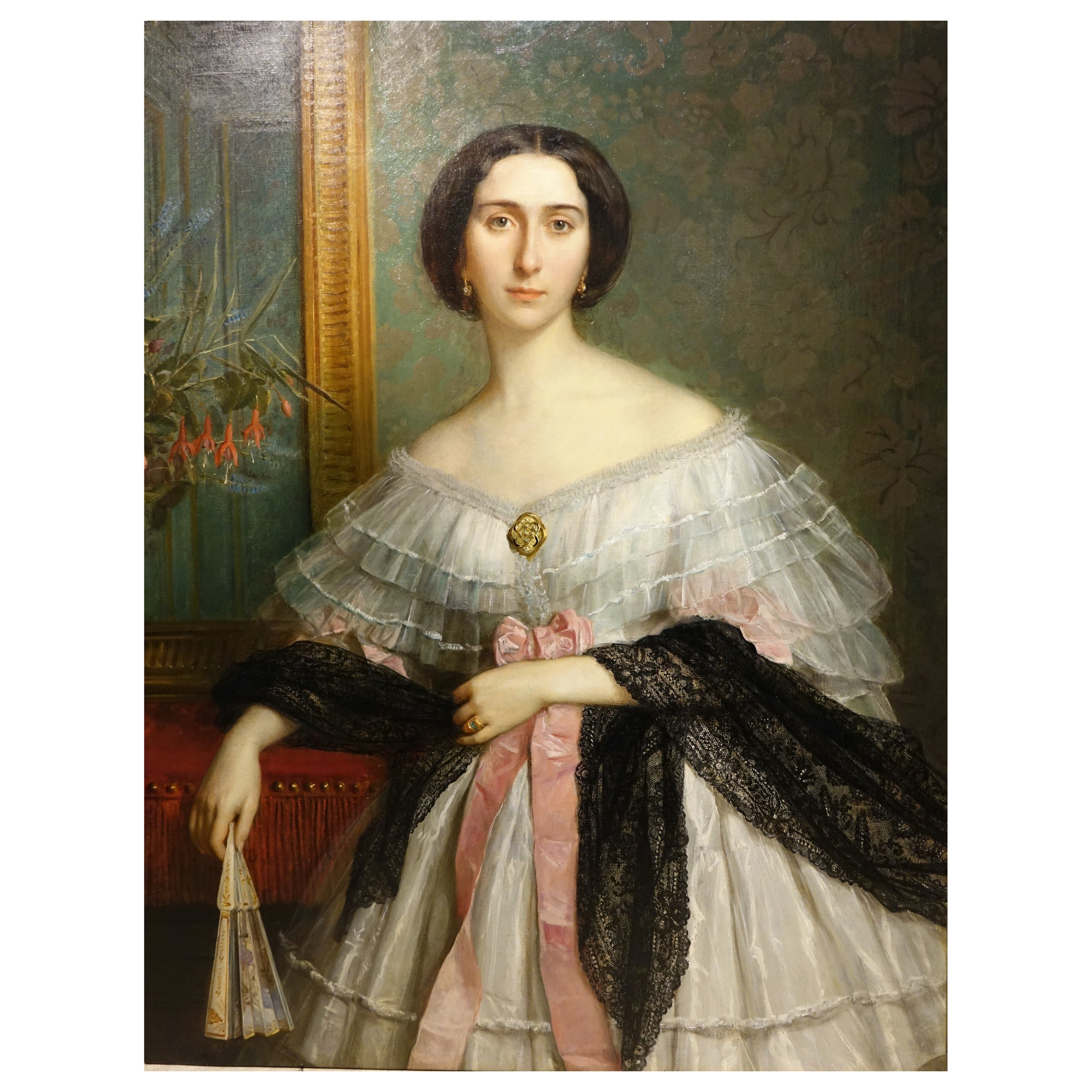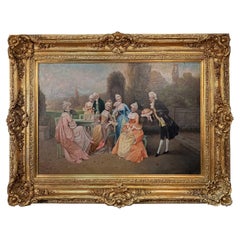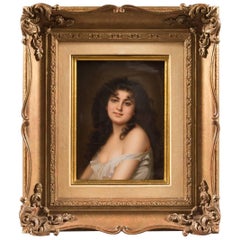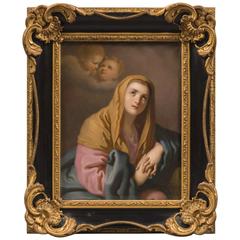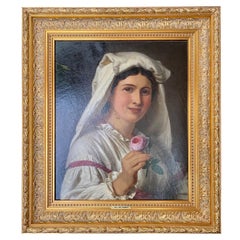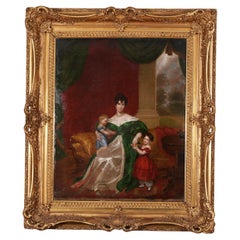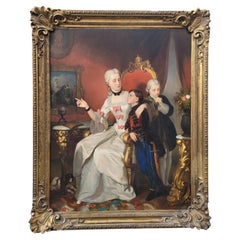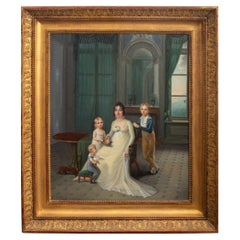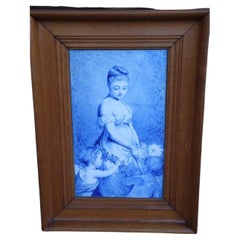Items Similar to Charles Chaplin (French, 1825-1891) Portrait de la famille Gros
Want more images or videos?
Request additional images or videos from the seller
1 of 17
Charles Chaplin (French, 1825-1891) Portrait de la famille Gros
$78,000
£59,635.15
€68,687.65
CA$109,301.91
A$122,025.31
CHF 63,939.43
MX$1,493,709.56
NOK 812,031.37
SEK 765,642.48
DKK 512,622.98
Shipping
Retrieving quote...The 1stDibs Promise:
Authenticity Guarantee,
Money-Back Guarantee,
24-Hour Cancellation
About the Item
Charles Chaplin (French, 1825-1891)
Portrait de la famille Gros, placed in an ornate hand carved gilt wood frame.
signed and dated 'Ch. Chaplin. 1860' (lower left)
oil on canvas
Dimensions of Canvas 51" x 38½" (129.5cm x 97.8 cm.)
Dimensions of Frame: 74.5" x 56" (189.2cm x 142.2cm.)
Painted in 1860.
- Creator:Charles Chaplin (Artist)
- Dimensions:Height: 74.5 in (189.23 cm)Width: 56 in (142.24 cm)Depth: 6 in (15.24 cm)
- Style:Neoclassical (In the Style Of)
- Materials and Techniques:
- Place of Origin:
- Period:
- Date of Manufacture:1860
- Condition:Wear consistent with age and use.
- Seller Location:Los Angeles, CA
- Reference Number:1stDibs: LU986237644792
Charles Chaplin
Charles Joshua Chaplin was born in France to an English father. He was one of the pupils of Michel Martin Drolling at the l'École nationale supérieure des Beaux-Arts in 1845. Chaplin’s style is inspired by the Rococo painting and from the work of Jean-Baptiste-Siméon Chardin and Jean-Etienne Liotard. His work was appreciated by the empress Eugenia and had several commissions from the Opéra and the Tuileries Palace. Official artist of the Second Empire, he was classified as "Art Pompier". Chaplin exhibited his works at the Salon from 1845–68.
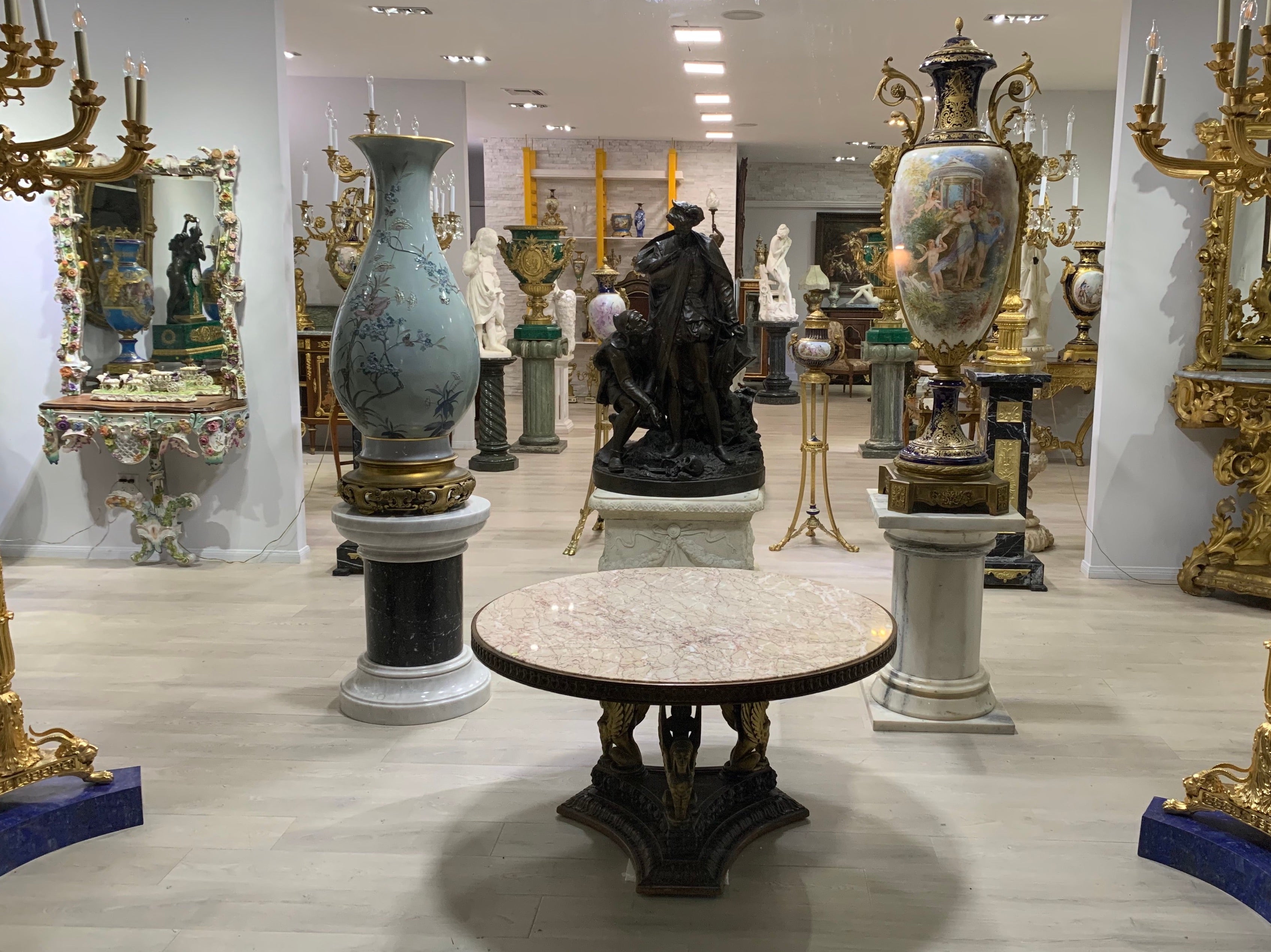
About the Seller
5.0
Vetted Professional Seller
Every seller passes strict standards for authenticity and reliability
Established in 1965
1stDibs seller since 2013
56 sales on 1stDibs
Typical response time: 1 hour
- ShippingRetrieving quote...Shipping from: Los Angeles, CA
- Return Policy
Authenticity Guarantee
In the unlikely event there’s an issue with an item’s authenticity, contact us within 1 year for a full refund. DetailsMoney-Back Guarantee
If your item is not as described, is damaged in transit, or does not arrive, contact us within 7 days for a full refund. Details24-Hour Cancellation
You have a 24-hour grace period in which to reconsider your purchase, with no questions asked.Vetted Professional Sellers
Our world-class sellers must adhere to strict standards for service and quality, maintaining the integrity of our listings.Price-Match Guarantee
If you find that a seller listed the same item for a lower price elsewhere, we’ll match it.Trusted Global Delivery
Our best-in-class carrier network provides specialized shipping options worldwide, including custom delivery.More From This Seller
View AllLarge 19th Century French Oil on Canvas by Jules Garson
Located in Los Angeles, CA
A 19th century French oil painting on canvas depicting classical figures in landscape, with a standing gentleman presenting bouquet of flowers to a sitting lady.
Signed: Jules Garson...
Category
Antique Late 19th Century French Paintings
Materials
Canvas
Very Fine 19th Century KPM Plaque Depicting a Young Beauty/Framed
By K.P.M. Berlin
Located in Los Angeles, CA
A very fine 19th century K.P.M plaque depicting a dark hair Blue eyed young beauty, within a giltwood frame.
Plaque signed M.N Suhel.
Rear marked with K.P.M and Sceptre mark.
Dim...
Category
Antique Late 19th Century German Decorative Art
Materials
Porcelain
Large 19th Century Berlin Rectangular KPM Porcelain Painted Framed Plaque
By KPM Porcelain
Located in Los Angeles, CA
A large 19th century Berlin Rectangular K.P.M porcelain painted framed plaque
Germany, circa 1880
Very well painted depicting a women draped in linens with two angels above h...
Category
Antique 1880s German Napoleon III Paintings
Materials
Porcelain
Antique English Oil/Canvas of a Young Girl Holding a Rose After William Hammer
By Hammer
Located in Los Angeles, CA
Antique English Oil/Canvas of a Young Girl holding a Rose after William Hammer, within a gilt frame, ready to be hung.
Category
Antique 19th Century English Classical Roman Paintings
Materials
Canvas
Large Berlin K.P.M Plaque of Young Jesus
Located in Los Angeles, CA
Period: 19th century
Origin: Germany
Style: Rococo
Framed
Height: 36″
Width: 27″
Plaque
Height: 16.5″
Width: 13.5″
With gilt-wood frame
Maker: K.P.M. Koni...
Category
Antique 19th Century German Paintings
19th Century Oil Painting on Canvas after Francois Boucher
Located in Los Angeles, CA
This magnificent painting dates to the 19th century after the original by Francois Boucher.
François Boucher was a French painter, draughtsman and et...
Category
Antique 19th Century European Paintings
Materials
Canvas
You May Also Like
Early 19th Century Oil Painting French Family Portrait
Located in 263-0031, JP
The term “Biedermeier” was first wielded as mildly disparaging designation for the bourgeois domesticity, so idealized by German society in the post-Napoleonic era prior to the 1848 ...
Category
Antique Early 19th Century French Biedermeier Paintings
Materials
Canvas
C Hermelein, Portrait Of Princess Elisabeth Of Prussia And Her Sons, 19th Centur
Located in MARSEILLE, FR
Very large portrait of Princess Elisabeth of Prussia with her two sons Louis (future Grand Duke of Hesse) and Henry (Prince of Hesse and the Rhine, general of the cavalry): she is de...
Category
Antique 19th Century European Napoleon III Paintings
Materials
Canvas, Stucco, Paint
Francois Kinson Family Portrait Oil on Canvas
Located in Astoria, NY
Francois Joseph Kinsoen (Flemish, 1770-1839) Attributed, Family Portrait, Oil on Canvas, circa 1825, signed "F. Kinson" lower left, depicting a mother figure and her three children i...
Category
20th Century Mid-Century Modern Paintings
Materials
Canvas, Paint
$8,200 Sale Price
36% Off
Beautiful Framed 19TH C Painting on Porcelain Woman Children Charles Chaplin
Located in New York, NY
The Following Item we are offering is a Beautiful Museum Quality Painting on Porcelain of a Woman surrounded by Cherubs holding Garland. Magnificently done with Outstanding Detail. Framed in a Beautiful Wooden Frame, inscribed Ch. Chaplin. Taken out of the Penthouse Estate of the President of Prestige Jewelers Upper East Side, New York City.
Framed Measurements: 24" H x 33" W
Charles Joshua Chaplin (8 June 1825 – 30 January 1891) was a French painter and printmaker who painted both landscapes and portraits. He was an accomplished artist mastering different techniques such as pastels, lithography, watercolor, chalk, oil painting and etching. He was best known for his elegant portraits of young women.
Charles Joshua Chaplin was born on 8 June 1825 in Les Andelys, Eure, France. His mother, Olympia Adelle Moisy, was French, whereas his father, John Chaplin, was an art broker from England. Charles Chaplin spent his whole life in France, becoming a naturalized citizen in 1886.[1][2] He studied at the École des Beaux-Arts in Paris from 1840, and he took private lessons in the studio of Michel Martin Drolling, whose apprentices included Paul Baudry, Jules Breton and Jean-Jacques Henner. Later he also taught at the École des Beaux-Arts.[2]
In 1845 he entered the Salon de Paris, the official art exhibition of the Académie des Beaux-Arts, as a portrait and landscape painter with the painting Portrait of the Artist's Mother. Chaplin conducted art classes specifically for women at his studio. The American artist Mary Cassatt, the French artist Louise Abbéma and the English artist Louise Jopling were among Chaplin's students. His son Arthur Chaplin was also a painter. Chaplin died on 30 January 1891 in Paris as a wealthy man and is buried in the Père Lachaise Cemetery.[3][4]
Chaplin made his debut at the Salon with portraits, but he also painted landscapes, particularly the countryside of Auvergne. His early works, from 1848 to 1851, were painted in a more realistic style, and are characterized by an interest in realism, which was a style that had been reestablished in France by the French Second Republic, that had the motto Liberté, égalité, fraternité, and was ruled for three years by the republican government of France from the 1848 Revolution until the 1851 coup by Louis-Napoléon Bonaparte. Realism was an artistic movement that began in France in the 1850s, after the 1848 Revolution.[5] From the late 18th century Romanticism dominated French art and literature but was spurned by Realists, who revolted against the display of the emotions of the Romantic movement, seeking to depict real and characteristic contemporary individuals and situations with truth and accuracy.[6]
Chaplin painted many works in his early days, including floral studies that were displayed at the Salon de las Flores. Later, in the late 1850s, he abandoned naturalism, his earlier style, exchanging it for a more graceful, elegant and supple technique that brought him a certain notoriety in France during his time as a portrait painter; as such he embraced the idyllic and voluptuous and fashionable style of the prominent French painter, François Boucher (1703–1770).[7]
He also embraced the tradition of the great English portraitists. He developed his very own style of painting but was inspired by the British painters Joshua Reynolds and Thomas Gainsborough. He used to engrave the works of the Dutch artist Pieter Paul Rubens and gained further influence from his work.[2]
Later work
Gradually the muddy colours used by Chaplin transformed into white, grey and pink, depicting his models with an opalescent, mother-of-pearl complexion by applying a subtle palette of rosy flesh tones and light greys. After painting portraits and trying his skills on ornamental painting, Chaplin took up genre painting in the 1850s. His favourite subjects are the feminine grace of a young woman’s everyday life. He portrays women in several poses: resting; grooming; singing; and reading. He captures them with lightness and carelessness and accentuates the decorative elements of the composition.[2]
Empress Eugénie, the wife of Napoleon III and an admirer of the "Pompadour style", rapidly fell under the enchantment of the painter's neo-Rococo works. Chaplin was among Napoleon III and Empress Eugénie’s favourite court artists. In 1859, when his portrait of Aurora was banned by the judges of the Salon as "too erotically suggestive", Napoléon III defended Chaplin and overturned the disqualification order.[8] He was similarly valued as an interior decorator and was appointed to remodel the decor of Empress Eugénie's rooms.[8]
His sensual portraits of women and young girls, often with models posed erotically in hazy surroundings and frequently wearing transparent clothing, attracted the interest of the high society and aristocracy of Paris during the French Third Republic (1870–1940) guaranteeing his success and wealth. He was one of the most popular painters of his time, but nowadays his work is almost unknown, in spite of the fact that his works hang in many major museums around the world.[2]
He employed his Rococo style for his mythological scenes and genre scenes paintings. His genre pictures formed a significant part of his work. In 1861, working as a decorative painter. Chaplin painted the doors and several glass panels above them of the Salon des Fleurs in the Tuileries Palace.[3] The Palace was gutted by fire in 1871 and its ruins swiftly demolished.[9] He also undertook decorating work in the Salon de l’Hémicycle of the Palais de l’Elysée.[3]
Honours and awards
A Song Silenced, Private collection.
As a member of the Académie royale de peinture et de sculpture, Chaplin exhibited his paintings at the Salon de Paris, the official exhibition venue of members' work. He began exhibiting his paintings at the French Artists' Salon in 1845 and was represented there habitually each year. These exhibitions made him one of France's most famous portrait artists. Commencing in 1847, his work was exhibited regularly at the Royal Academy in London.[8]
During his lifetime he received acclamation for his artistic talents by the award of several medals: a third class medal in 1851; a second class medal the following year; and an Honour Medal...
Category
20th Century Unknown Porcelain
Materials
Porcelain
$4,320 Sale Price
76% Off
Free Shipping
19th Century Painting jules arsene garnier
Located in Esbeek, NL
Jules-Arsène Garnier (1847–1889) was a French painter known for his historical and genre works. Born in Paris, he began his education at the Académie de Toulouse, one of the most pre...
Category
Antique 19th Century Paintings
Materials
Wood
$7,088 / set
Portrait of a young aristocrat, France Circa 1850
Located in PARIS, FR
Large oil on canvas portraying a young woman of fine character, undoubtedly an aristocrat, French school circa 1850.
According to family tradition, this is the portrait of Countess H...
Category
Antique 1850s French Napoleon III Paintings
Materials
Canvas
More Ways To Browse
Antique Chippendale China Cabinet
Antique Dog Clock
Antique Fern Prints
Antique Military Campaign Chest
Asian Low Chairs
Baker New World
Bishop Table
Black And White Staffordshire
Black Chinoiserie Screen
Black Forest Chamois
Bramin Teak
Brazilian Wood Carving
Bronze Giraffe
Bronze Sea Horse
Buffalo Hide
Business Card Holder
Carved Giltwood Italian Wall Brackets
Carved Serpentine Chinese
